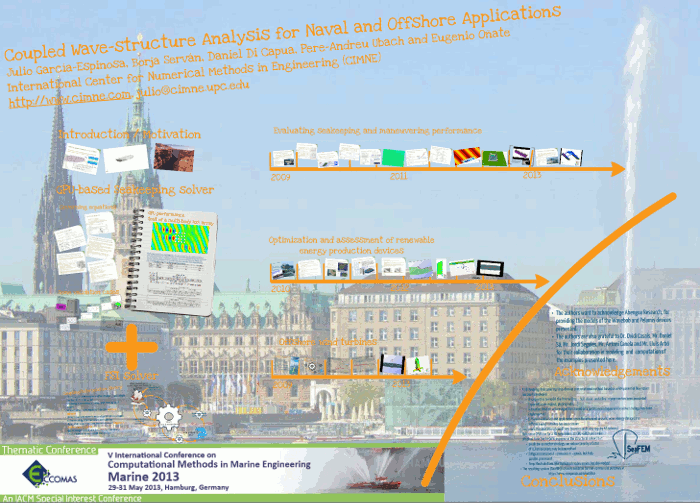ABSTRACT
Wave-structure interaction is a topic of great interest in naval and offshore engineering. This interest is growing in the last years due to the boost given by the development of the marine renewable energy field. In this context the development of an efficient time-domain coupled waves-structure solver is a main request from the industry.
Up to date the numerical seakeeping simulation has been mostly carried out using the frequency domain. The reason might be that the computational cost of time domain simulations were too high and computational time was too large. Moreover assumptions like linear waves and the harmonic nature of water waves made the frequency domain to be the right choice. However nowadays computing capabilities make possible to carry out numerical simulations in the time domain in a reasonable time, with the advantage of making easier the introduction of non-linearities into the algorithm and therefore coupling with other phenomena.
This paper presents the work of the authors in developing a time-domain unstructured Finite Element Method (FEM) algorithm for analysis of coupled wave-structure interaction. For this purpose, a new diffraction-radiation solver using the FEM was developed. The solver has been implemented in GPU, using CUDA architecture. The speed-up obtained ranges from 5 to 10 times compare to the implementation in a standard CPU with a conjugate gradient and ILU preconditioner.
The seakeeping analysis tool has been integrated within a coupled waves-structure analysis tool. The coupling algorithm is based on a partitioned iterative algorithm, using an interpolation library able to communicate pressure forces and displacements of the structure at memory level. Furthermore, an innovative wetting and drying scheme able to improve the evaluation of the water action on the structure.
The accuracy of the new seakeeping formulation for analysis of waves and floating structures interaction has been verified in different validation cases and practical applications.
PRESENTATION
This presentation was held at the MARINE 2013 conference on May 30th, 2013.
REFERENCES
[1] Oñate E. & García, J., A finite element method for fluid-structure interaction with surface waves using a finite calculus formulation, Comp. Methods Appl. Mech. and Engrg. 2001; 191: 635-660.
[2] García, J., Valls A., & Oñate, E., ODDLS: A new unstructured mesh finite element method for the analysis of free surface flow problems, Int. J. Numer. Meth. Fluids 2008; 76 (9): 1297-1327.
[3] Wu, G.X. & Eatock Taylor, R., Finite element analysis of two dimensional non-linear transient water waves, Appl. Ocean Res. 1994 ; 16: 363-372.
[4] Wu, G.X. & Eatock Taylor, R., Time stepping solution of the two dimensional non-linear wave radiation problem, Ocean Eng. 1995; 22: 785-798.
[5] M.S. Turnbull, A.G.L. Borthwick and R. Eatock Taylor, Wave-structure intersection using coupled structured-unstructured finite element meshes, Applied Ocean Research 2003; 25: 63–77.
[6] Aubry, R., Mut, F., Löhner, R., and Juan R. Cebral, J. R., Deflated preconditioned conjugate gradient solvers for the Pressure–Poisson equation, J. Comp. Phys. 2008; 227: 10196-10208.
[7] Bell, N. and Garland, M., Effcient Sparse Matrix-Vector Multiplication on CUDA, NVIDIA Technical Report NVR-2008-004, Dec. 2008.
[8] Clauss, G. F. , Schmittner, C., and Stutz, K., Time-domain investigation of a semisubmersible in rouge, 21st International Conference on Offshore Mechanics and Arctic Engineering June 23-28, 2002, Oslo, Norway. OMAE2002-28450.
[9] Evaluating Manoeuvering and Seakeeping Performance of a Surface Effect Ship. Technical Report, CIMNE IT-630, October 2012.
Document information
Published on 08/08/17
Submitted on 08/08/17
Licence: CC BY-NC-SA license
